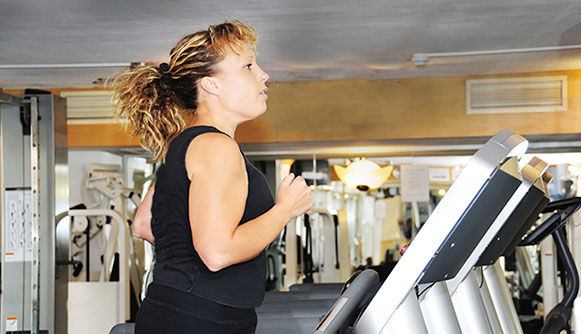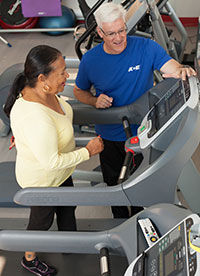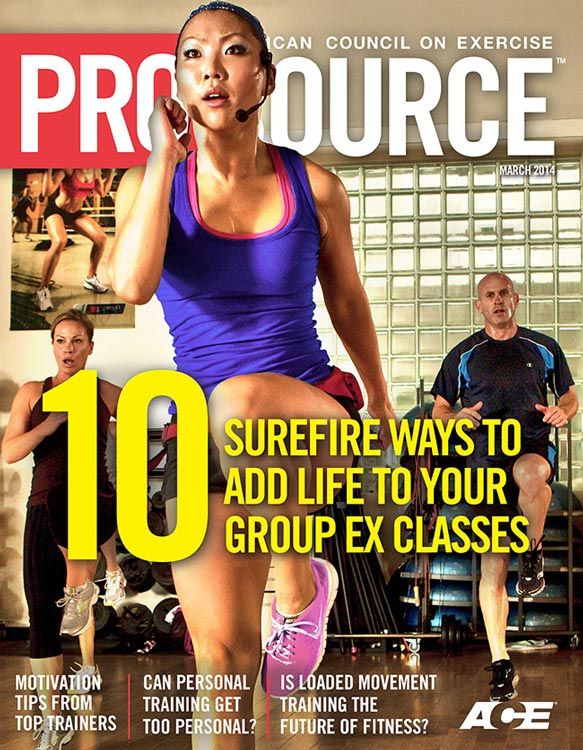
If you work with highly unfit or overweight clients, the latest ACE-commissioned study offers important findings for how to safely increase the intensity of your clients’ walking workouts through the use of weighted vests. Plus, we include several ready-to-go walking workouts that you can begin using with your clients today.
For most newcomers to exercise, the first modality recommended by their primary physicians and fitness professionals is treadmill walking, due to its accessibility, ease of use and health benefits. For unfit, previously sedentary clients, finding the right intensity that balances personal comfort with the need to elicit metabolic changes can be difficult. Traditionally, there have only been two means of increasing intensity during treadmill walking as fitness improves: increased speed or increased incline. But for some clients, walking faster is simply not an option. As Cedric X. Byrant, Ph.D., ACE’s Chief Science Officer, explains, “As speed increases, client discomfort and perceived exertion also increase, sometimes to the point where they outpace the metabolic improvements. Couple this with a condition that limits a person’s ability to walk more quickly, such as plantar fasciitis or low-back pain, and you have a sure recipe for client drop-out.”
The goal, then, is to help these clients burn more calories without having them walk at speeds that dramatically increase their ratings of perceived exertion (RPE) or extend beyond their comfort zone. But with only incline at the fitness professional’s disposal, this may be difficult. The use of weighted vests, however, may offer a practical solution. “Adding a weighted vest doesn’t feel as challenging as an increase in speed, so clients get more benefit without feeling like they’re overdoing it,” says Dr. Bryant.
It is important that fitness professionals talk with clients’ physicians (with the client’s written permission) before using weighted vests in their workouts. There are certain conditions, including such common ailments as arthritis, severe osteoporosis and chronic obstructive pulmonary disease, where the use of a weighted vest would be contraindicated.
Len Kravitz, Ph.D., along with James J. McCormick, M.S., both of the University of New Mexico’s Exercise Physiology Laboratory, conducted an ACE-commissioned study investigating the metabolic cost of slow graded treadmill walking with a weighted vest with a goal of examining how oxygen consumption, relative exercise intensity and RPE are affected while wearing a weighted vest. Dr. Kravitz was also interested in not only identifying the optimal grade and vest weight needed to burn the peak amount of calories, but also in helping fitness professionals design walking programs for sedentary populations and providing evidence-based walking workouts that fitness professionals and walking enthusiasts can implement immediately.
The Study

For this study, Dr. Kravitz recruited 13 untrained female subjects, ages 18 to 55, from the University of New Mexico campus and the surrounding community. After completing a six-minute walk test without wearing a weighted vest (this same test was used to determine each participant’s estimated VO2max), each subject was randomly assigned to wear no vest, wear a vest weighing 10% of her body weight (10%BM) or wear a vest weighing 15% of her body weight (15%BM).
For each trial, subjects walked at a constant speed of 2.5 miles per hour (mph), with incremental gradient increases (0%, 5%, 10% and 15%) for four minutes each (16 minutes of total walking time). According to Dr. Kravitz, this speed was chosen because it is typically a comfortable walking speed for unfit individuals. After the first eight minutes, subjects rested for 10 minutes or until their pre-exercise heart rate was achieved. They also rested for 10 minutes between the 10% and 15% incline stages. Researchers measured the following during each exercise trial:
• Oxygen consumption (VO2)
• Heart rate
• Ratings of perceived exertion (using the 6–20 scale each minute throughout each trial)
The results of the study showed that wearing a weighted vest increases VO2 during graded, slow walking. That said, the results were not as simple as “more weight + more incline = more calories burned.” For example, when walking without an incline, a 10%BM vest did not create a significant increase in VO2; the 15%BM vest was needed to yield a significant increase in metabolic cost. In addition, an increase in vest weight from 10%BM to 15%BM had no effect on metabolic cost at the highest incline (15% gradient), possibly due to the biomechanical differences associated with graded walking.
What Do These Results Mean to Fitness Professionals?
While working through the full report of the study’s results can become a bit confusing in terms of understanding the various combinations of incline and weighted vest and their impact on metabolic cost, there are a few key take-away points that Dr. Kravitz says are directly applicable to the daily practice of fitness professionals.
It should be noted that these results can be applied to both male and female clients. "Because energy patterns are comparatively similar for unfit men and women," explains Dr. Kravitz, "these same recommendations can be applied to both genders."
Walking at 2.5 mph at a 0% incline with a weighted vest of about 15% BM elicits a 12% increase in the number of calories burned over not wearing a vest. “This is a very meaningful increase in caloric expenditure,” says Dr. Kravitz. “And it can be very important in the real world, where some clients don’t own treadmills. For example, older adults who get their exercise walking at the mall can see real results from wearing a 15% BM weighted vest.”
If you have clients who are walking on the treadmill, it is important to note that when walking at 2.5 mph at a 5% or 10% grade, an untrained female expends 13% more calories when wearing 10%BM vest. There is no significant benefit to wearing a 15%BM vest at this incline.
One recommendation gathered from the data of this study suggests that exercise adherence may decrease for beginning exercisers if relative exercise intensity is too high in the first four to six weeks of a treadmill walking program. Therefore, exercise intensity should be increased gradually. Beginning exercise walkers are encouraged to stay below 15% treadmill walking grades during the early weeks of an exercise walking program. This provides sufficient time for the body to adapt before attempting more challenging walking workouts.
By incorporating weighted vests into their training arsenal, fitness professionals arm themselves with an additional tool that can be used to modify exercise intensity and help avoid workout monotony. This is especially important for newcomers to exercise who are trying to establish a new lifestyle behavior—the very same people who may be too unfit to progress their workouts through increases in speed. Weighted vests can therefore become an important piece of equipment for any fitness professional.
THE WORKOUTS
From this research, the following walking workouts are suggested for personal trainers to progressively introduce to their entry-level clients. All workouts begin with a warm-up consisting of a 5- to 10-minute self-selected walking speed at a 0% grade. The goal intensity for all of these workouts is a “somewhat hard” to “hard” level of perceived exertion.
Workout 1—Metabolic Base Walking With a Weighted Vest
• Walking speed: 2.5 mph
• Treadmill grade: 0%
• Vest weight: 15% of body weight
• Duration: 20 to 60 minutes
Workout 2—Stepwise Graded Walking (with or without vest)
• Walking speed: 2.5 mph
• Vest weight (if worn): 10% of body weight
• Treadmill gradients:
— 0% for 4 minutes
— 5% for 4 minutes
— 10% for 4 minutes
— 15% for 2 minutes
— 5% for remainder of workout
• Duration: 20 to 60 minutes
Workout 3—Interval Walk Training (with or without vest)
• Walking speed: 2.5 mph
• Vest weight (if worn): 10% of body weight
• Interval workout with the following intervals:
— Work interval: 10% or 15% grade for 2 minutes
— Recovery interval: 0% grade for 4 minutes
• Duration: Repeat work and recovery intervals for 20 to 30 minutes
Workout 4—Three Big Effort Walk Workout (with or without vest)
• Walking speed: 2.5 mph
• Vest weight (if worn): 10% of body weight
• Grade: 5%
• Three times during the walk (at the beginning, middle and end), take the treadmill grade up to 15% and walk for 1.5 minutes. Then, return the grade to 5% and continue walking.
• Duration: 20 to 60 minutes
Workout 5—Interval Hill Walk Workout (with or without vest)
• Walking speed 2.5 mph
• Vest weight (if worn): 10% of body weight
• Interval workout with the following intervals:
—Work interval: 10% or 15% grade for 45 seconds
—Recovery interval: 5% grade for 3 minutes
• Repeat work and recovery intervals for 20 to 30 minutes





 by
by 



